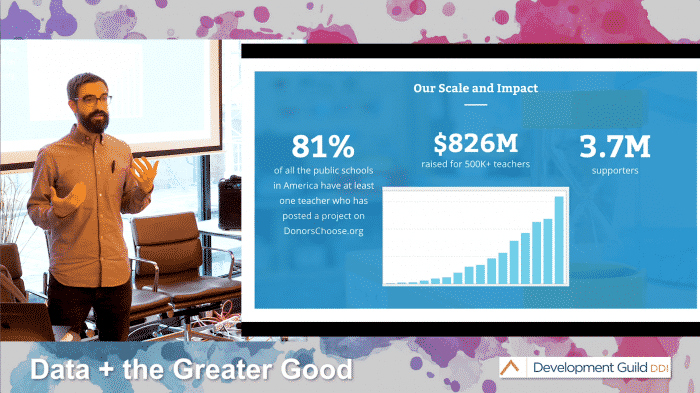Our latest Data + the Greater Good Meetup featured guest speaker Stephen Burke, Digital and Growth Marketing Manager, at DonorsChoose.org. DonorsChoose.org is the leading platform for giving to public schools. Teachers across America use the site to create and promote projects for their students, and donors give to the projects that inspire them – whether it be donating copies of their favorite book to a classroom in need or providing art supplies to a teacher from their hometown. The site prioritizes transparency; each project includes an explanation from the teacher about the product they’re requesting and the cost. In addition, website visitors can always find updated data regarding dollars raised, students helped, teachers and projects funded, and schools and donors participating. Since its founding by a high school history teacher in the Bronx in 2000, the crowdfunding site has raised $826M for more than 500 thousand teachers with the help of 3.7M donors. Furthermore, 81% of all public schools in America have at least one teacher who has posted a project on DonorsChoose.org!

When Stephen first joined the organization 3 years ago, he focused primarily on their social media. Since then, his role has expanded and his interest in and use of data has grown, as well. Read on to discover how DonorsChoose.org thinks about data and how it informs their decision-making, helps them to understand the marketplace, and enhances their efforts to engage donors…
How Does DonorsChoose.org Think About Data?
Data permeates DonorChoose.org’s culture. Stephen shared how various teams use data to enhance and improve the work they do: the operations team uses data to analyze and reduce the amount of time it takes to ship products to schools; the customer service team uses data to study incoming requests and improve the website/processes to decrease the frequency of such requests; the partnerships teams—whose main responsibility is to engage corporate partners for support—creates custom dashboards so corporations can track their contributions; and the marketing team uses data to learn about donors and teachers and improve their emails and messaging (watch the clip below to understand the impact of these emails!).
So, how does DonorsChoose.org uses data to make decisions?
DonorsChoose.Org Uses Data to Make Decisions
When the data available is abundant, it’s crucial to decide which data is worth analyzing. Stephen emphasized the importance of looking at specific data at specific times. Every morning, everyone at the organization receives an email that details the revenue that was raised the previous day, the number of projects that were funded, and the current success rate of all projects on the website. On a weekly basis, Stephen may review the top twenty automated emails that went out to see what the open rates were and how much money they raised, and on a monthly basis, Stephen and his team might review which parts of the marketplace need more help (due to either a lack of projects of a lack of donors). This year, for instance, Stephen and his team analyzed data to discover that their slowest area of growth was with new donors who weren’t referred by teachers (perhaps they found out about the organization because of an ad, social media, a digital event, etc.). Armed with this knowledge, Stephen and his team can now focus on capturing this audience more effectively in the coming year. Watch the clip below to discover how testing will help them do just that.
DonorsChoose.org Uses Data to Understand the Marketplace
To remain relevant and effective, it’s critical that DonorsChoose.org understand the marketplace and larger trends in the education field. Stephen provided a couple of examples of trends they’ve witnessed through data collection:
- Since 2004, the percentage of projects requesting technology has grown from 2% in 2004 to 29% in 2014. This illustrates the growing role of technology in the classroom and informs how DonorsChoose.org pitches potential corporate sponsors.

- In 2006, 7% of projects requested cameras; in 2016, only 2% did (most teachers now have phones with cameras they can use!). This data helps DonorsChoose.org track social trends and understand what’s going on in America’s classrooms.

Stephen also emphasized the power of machine learning in understanding their marketplace and how he hopes it will allow them to better personalize and segment their messaging in the future:
DonorsChoose.Org Uses Data to Share Their Impact
Donors want to feel like they’re part of a larger community and that their impact is greater than their individual gift. Last January, DonorsChoose.org was coming up on a large milestone: 1 million funded projects. To celebrate this achievement, and grow their impact even more, the organization launched a new campaign, entitled #FirstMillion. Stephen explains what the campaign entailed, why it was such a success, and what it taught them:
So what’s next? Automation! Stephen and his team hope to automate these personal impact emails so a donor will automatically receive an email once they’ve given to more than 3-5 projects. The e-mail would go out when the donor had just given and/or when they’re most likely to give again. Automation would mean moving away from time-consuming 1-day events that need to be planned well in advance and towards a more personalized—and hopefully effective—approach.
Takeaways
As DonorsChoose.org continues to utilize data in new and interesting ways, Stephen provided the following tips an organization can follow to ensure success:
- Turn everyone into a data scientist – If all staff members are on board, tuned in, and excited, you can accomplish more with your data.
- Test everything (and get personal!) – It’s the only way to figure out what kinds of messaging work and what don’t.
- Keep up with the trends – Be open to trying new data tools and constantly evaluating your data usage.
And perhaps, the most important takeaway of all: data, as powerful as it may be on its own, is even more so when paired with effective storytelling.
Click to learn more about DonorsChoose,org, watch Stephen’s presentation in full, or join the Data + the Greater Good Meetup group.



